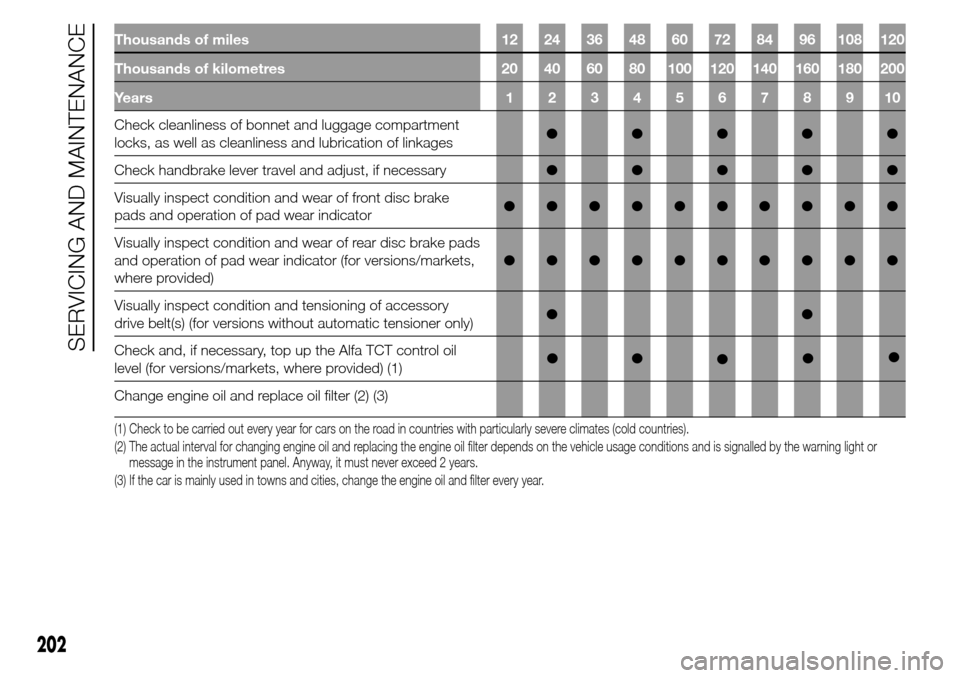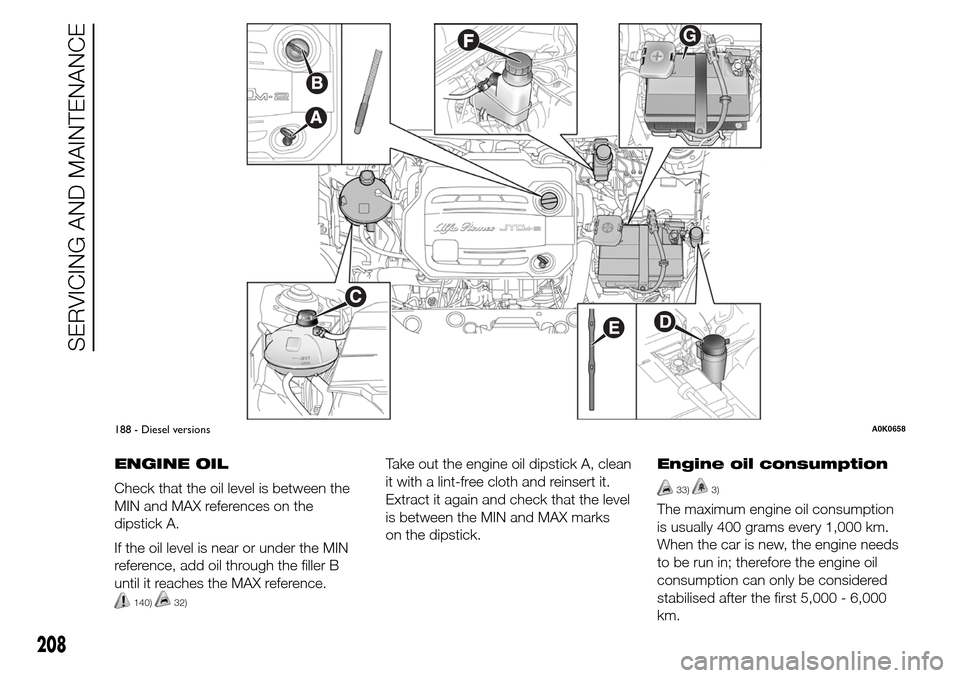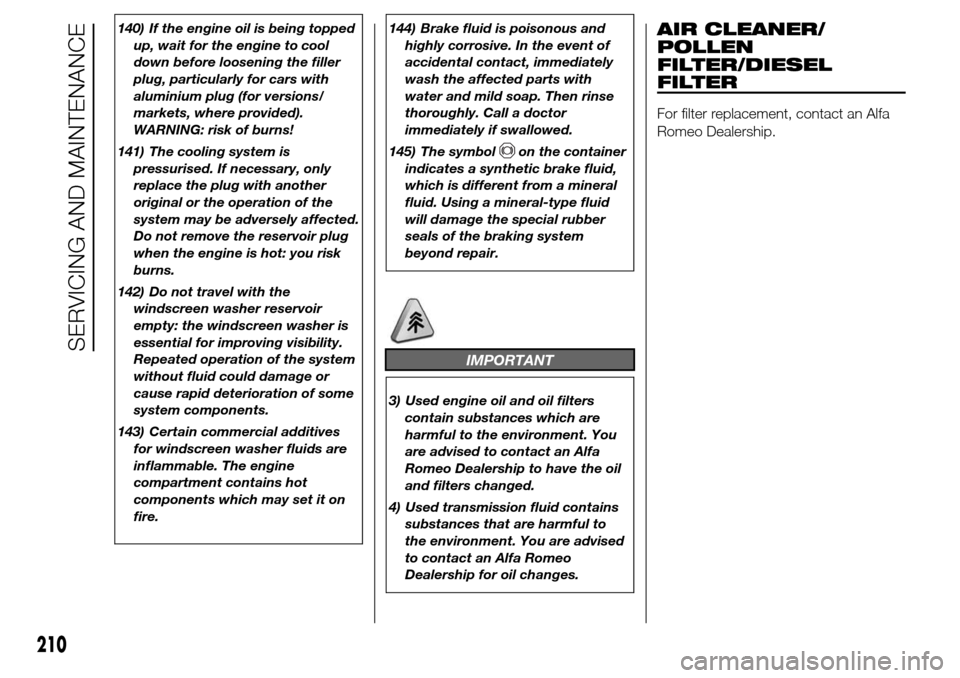2015 Alfa Romeo Giulietta engine oil
[x] Cancel search: engine oilPage 203 of 288

Thousands of miles 9 18 27 36 45 54 63 72 81 90
Thousands of kilometres 15 30 45 60 75 90 105 120 135 150
Years12345678910
Change engine oil and replace oil filter (1750 Turbo Petrol
versions) (3)
Replace spark plugs (1.4 Turbo Petrol and 1.4 Turbo
MultiAir versions) (4)●●●●●
Replace spark plugs (1750 Turbo Petrol versions)●●
Replace accessory drive belt(s) (5)●
Replace toothed timing drive belt (5)●
(3) The actual interval for changing engine oil and replacing the engine oil filter depends on the vehicle usage conditions and is signalled by the warning light or
message in the instrument panel. Anyway, it must never exceed 1 year.
(4) For 1.4 Turbo Petrol and 1.4 Turbo MultiAir versions, to guarantee correct operation and prevent serious damage to the engine, it is essential to proceed as
follows: only use spark plugs specifically certified for these engines; all spark plugs should be of the same type and brand (see the “Engine” paragraphinthe
“Technical specifications” section); strictly comply with the replacement intervals in the Scheduled Servicing Plan. It is advisable to contact anAlfa Romeo
Dealership for spark plug replacement.
(5) Areas that are not dusty: advised maximum mileage 120,000 km. Regardless of the mileage, the belt must be replaced every 6 years.
Dusty areas and/or demanding use of the car (cold climates, town use, long periods of idling): advised maximum mileage 60,000 km. Regardless of the mileage,
the belt must be replaced every 4 years.
199
Page 205 of 288

DIESEL VERSIONS
Thousands of miles 12 24 36 48 60 72 84 96 108 120
Thousands of kilometres 20 40 60 80 100 120 140 160 180 200
Years12345678910
Check tyre condition/wear and adjust pressure, if
necessary; check “Fix&Go Automatic” kit recharge expiry
date (for versions/markets, where provided)●●●●●●●●●●
Check operation of lighting system (headlights, direction
indicators, hazard warning lights, luggage compartment,
passenger compartment, glove compartment, instrument
panel warning lights, etc.)●●●●●●●●●●
Check and, if necessary, top up fluid levels (engine
coolant, hydraulic clutch/brakes, windscreen washer,
battery, etc.)●●●●●●●●●●
Check exhaust emissions/smokiness●●●●●●●●●●
Use the diagnosis socket to check supply/engine
management system operation, emissions and, for
versions/markets, where provided, engine oil degradation●●●●●●●●●●
Visually inspect condition of: exterior bodywork,
underbody protection, pipes and hoses (exhaust, fuel
system, brakes), rubber elements (boots, sleeves, bushes,
etc.)●●●●●
Check windscreen/rear window wiper blade position/wear●●●●●
Check operation of windscreen wiper/washer system and
adjust jets, if necessary●●●●●
201
The checks listed in the Scheduled Servicing Plan, after reaching 120,000 km/6 years, must be cyclically repeated starting from
the first interval, thus following the same intervals as before.
Page 206 of 288

Thousands of miles 12 24 36 48 60 72 84 96 108 120
Thousands of kilometres 20 40 60 80 100 120 140 160 180 200
Years12345678910
Check cleanliness of bonnet and luggage compartment
locks, as well as cleanliness and lubrication of linkages●●●●●
Check handbrake lever travel and adjust, if necessary●●●●●
Visually inspect condition and wear of front disc brake
pads and operation of pad wear indicator●●●●●●●●●●
Visually inspect condition and wear of rear disc brake pads
and operation of pad wear indicator (for versions/markets,
where provided)●●●●●●●●●●
Visually inspect condition and tensioning of accessory
drive belt(s) (for versions without automatic tensioner only)●●
Check and, if necessary, top up the Alfa TCT control oil
level (for versions/markets, where provided) (1)●
Change engine oil and replace oil filter (2) (3)
(1) Check to be carried out every year for cars on the road in countries with particularly severe climates (cold countries).
(2) The actual interval for changing engine oil and replacing the engine oil filter depends on the vehicle usage conditions and is signalled by the warning light or
message in the instrument panel. Anyway, it must never exceed 2 years.
(3) If the car is mainly used in towns and cities, change the engine oil and filter every year.
202
SERVICING AND MAINTENANCE●●●●
Page 208 of 288

PERIODIC CHECKS
Every 1,000 km or before long
journeys, check and, if necessary, top
up the following:
❒engine coolant, brake fluid and
windscreen washer fluid level;
❒tyre inflation pressure and condition;
❒operation of lighting system
(headlamps, direction indicators,
hazard warning lights, etc.);
❒operation of window washer/wiper
system and positioning/wear of
windscreen/rear window wiper
blades
Check and top up, if required, the
engine oil level every 3,000 km.
HEAVY-DUTY USE OF
THE CAR
If the car is used mainly under one of
the following conditions:
❒towing a trailer or caravan;
❒dusty roads;
❒short, repeated journeys (less than
7-8 km) at sub-zero outside
temperatures;
❒engine often idling or driving long
distances at low speeds or long
periods of idleness;
the following checks must be carried
out more often than indicated in the
Scheduled Servicing Plan:
❒check front disc brake pad
conditions and wear;
❒check cleanliness of bonnet and boot
locks, cleanliness and lubrication of
linkage;
❒visually inspect conditions of: engine,
gearbox, transmission, pipes and
hoses (exhaust - fuel system -
brakes) and rubber elements (boots -
sleeves - bushes - etc.);
❒check battery charge and battery
fluid level (electrolyte);
❒visually inspect condition of the
accessory drive belts;❒check and, if necessary, change
engine oil and replace oil filter;
❒check and, if necessary, replace
pollen filter;
❒check and, if necessary, replace air
cleaner.
204
SERVICING AND MAINTENANCE
Page 212 of 288

ENGINE OIL
Check that the oil level is between the
MIN and MAX references on the
dipstick A.
If the oil level is near or under the MIN
reference, add oil through the filler B
until it reaches the MAX reference.
140)32)
Take out the engine oil dipstick A, clean
it with a lint-free cloth and reinsert it.
Extract it again and check that the level
is between the MIN and MAX marks
on the dipstick.Engine oil consumption
33)3)
The maximum engine oil consumption
is usually 400 grams every 1,000 km.
When the car is new, the engine needs
to be run in; therefore the engine oil
consumption can only be considered
stabilised after the first 5,000 - 6,000
km.
G
188 - Diesel versionsA0K0658
208
SERVICING AND MAINTENANCE
Page 213 of 288

ENGINE COOLANT
If the level is too low, unscrew reservoir
cap C and add the fluid described in
the "Technical Specifications" section.
34)141)
WINDSCREEN/REAR
WINDOW WASHER FLUID
If the level is too low, lift reservoir cap D
and add the fluid described in the
chapter "Technical Specifications".
142) 143)
IMPORTANT The headlight washer
system will not operate when the fluid
level is low, even though the
windscreen/rear window washer
continues to operate. For versions/
markets, where provided, there is
a reference notch E on the dipstick (see
previous pages): ONLY the
windscreen/rear window wiper
operates with the level below this
reference.
BRAKE FLUID
Check that the fluid is at the max. level.
If the fluid level in the reservoir is too
low, undo reservoir cap E and add the
fluid described in the chapter "Technical
Specifications".
35)144) 145)
ALFA TCT ACTIVATION
SYSTEM OIL
(for versions/markets, where provided)
The transmission control oil level should
only be checked at an Alfa Romeo
Dealership.
4)
IMPORTANT
31) Be careful not to confuse the
various types of fluids while
topping up: they are not
compatible with each other!
Topping up with an unsuitable
fluid could severely damage your
car.
32) The oil level should never exceed
the MAX mark.
33) Do not add oil with specifications
other than those of the oil already
in the engine.34) PARAFLU
UPanti-freeze fluid is
used in the engine cooling
system; use the same fluid type as
that already in the cooling system
when topping up. PARAFLU
UP
may not be mixed with other types
of anti-freeze fluids. In the event
of topping up with an unsuitable
product, under no circumstances
start the engine and contact an
Alfa Romeo Dealership.
35) Avoid allowing brake fluid, which
is extremely corrosive, to come
into contact with painted areas.
Should it happen, wash
immediately with water.
WARNING
138) Never smoke when performing
operations in the engine
compartment. Flammable gases
and fumes may be present and
risk igniting.
139) Be very careful when working in
the engine compartment when
the engine is hot: you may get
burned.
209
Page 214 of 288

140) If the engine oil is being topped
up, wait for the engine to cool
down before loosening the filler
plug, particularly for cars with
aluminium plug (for versions/
markets, where provided).
WARNING: risk of burns!
141) The cooling system is
pressurised. If necessary, only
replace the plug with another
original or the operation of the
system may be adversely affected.
Do not remove the reservoir plug
when the engine is hot: you risk
burns.
142) Do not travel with the
windscreen washer reservoir
empty: the windscreen washer is
essential for improving visibility.
Repeated operation of the system
without fluid could damage or
cause rapid deterioration of some
system components.
143) Certain commercial additives
for windscreen washer fluids are
inflammable. The engine
compartment contains hot
components which may set it on
fire.144) Brake fluid is poisonous and
highly corrosive. In the event of
accidental contact, immediately
wash the affected parts with
water and mild soap. Then rinse
thoroughly. Call a doctor
immediately if swallowed.
145) The symbol
on the container
indicates a synthetic brake fluid,
which is different from a mineral
fluid. Using a mineral-type fluid
will damage the special rubber
seals of the braking system
beyond repair.
IMPORTANT
3) Used engine oil and oil filters
contain substances which are
harmful to the environment. You
are advised to contact an Alfa
Romeo Dealership to have the oil
and filters changed.
4) Used transmission fluid contains
substances that are harmful to
the environment. You are advised
to contact an Alfa Romeo
Dealership for oil changes.
AIR CLEANER/
POLLEN
FILTER/DIESEL
FILTER
For filter replacement, contact an Alfa
Romeo Dealership.
210
SERVICING AND MAINTENANCE
Page 252 of 288

FLUIDS AND LUBRICANTS
Your car is equipped with an engine oil that has been thoroughly developed and tested in order to meet the requirements of the
Scheduled Servicing Plan. Constant use of the prescribed lubricants guarantees the fuel consumption and emission
specifications. Lubricant quality is crucial for engine operation and duration.
PRODUCT SPECIFICATIONS
248
TECHNICAL SPECIFICATIONS
UseFluid and lubricant features for a correct use
of the carGenuine fluids and
lubricantsReplacement interval
Lubricant for
petrol engines
(1.4 Turbo Petrol
versions)
41)
SAE 5W-40 ACEA C3 grade totally synthetic
lubricant
FIAT 9.55535-S2 ificationSELENIA StAR P.E.
Contractual Technical
Reference No. F603.D08According to the
Scheduled Servicing
Plan
Lubricant for
petrol engines
versions)SAE 0W-30 ACEA C2grade totally synthetic
lubricant
FIAT 9.55535-S2specificationSELENIA P.E.
Contractual Technical
Reference No. F020.B12According to the
Scheduled Servicing
Plan
DIGITEK
(1.4 Turbo MultiAir
41)
spec